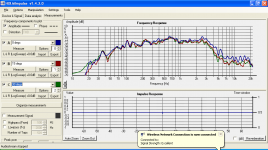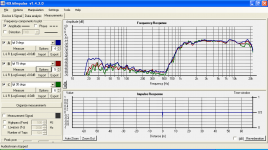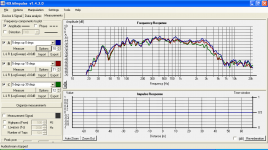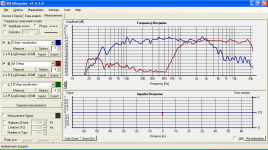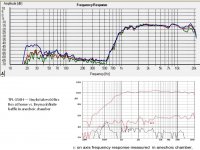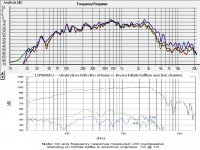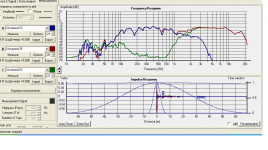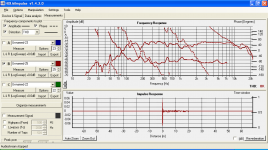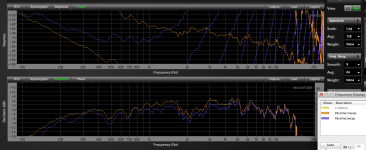Is the increased midrange detail only to be found below 350 Hz, or do you think the Beyma 12p80Nd v2 provides more detail above 350 Hz than the JBL 2482?
Thanks!
Best regards
Peter
Thanks!
Best regards
Peter
BTW - interestingly i am hearing midrange detail, i haven't previously heard with the JBL 2482's, must have been lost in the 350hz xover range. Sound abit like BG neo 10's on steroids, or what i imagine a few pairs in an array would sound like.
Not sure will have to do some more listening, to confirm. It could be i just needed some new diaphragms for my JBL 2482's.
Hi Vinylvalves,
Sorry to ask, I didn't understand if it was the OB version (raw driver) which have more details or the sealed too ?
QTC is choosed on the digital filter if my understanding is correct at reading your posts: which value was choosen for the test the test ? <0.4 ?
best regards
Eldam
Sorry to ask, I didn't understand if it was the OB version (raw driver) which have more details or the sealed too ?
QTC is choosed on the digital filter if my understanding is correct at reading your posts: which value was choosen for the test the test ? <0.4 ?
best regards
Eldam
I am sitting listening to a strange stereo arrangement. JBL 2482 on the left channel (350hz to 1300hz) with the Beyma 12P80nd on the right (80hz to 1600hz) To be honest its difficult to say which is which and which sounds better. The Beyma channel is definitely more detailed in the sub 300hz range but it lacks abit of presence. (maybe because its cleaner?)
Its not really a fair comparison, as i have only spent 10 mins setting up the new arrangement, and its not quite in phase or that level. So i will reserve judgement until i have tweeked abit more.
If some one can give me a simple summary of what measurements i need to do to hone the crossover i would appreciate it and of course i will post the results. BTW i only really have holmimpulse which i believe the results from (never mastered ARTA or TrueRTA)
Its not really a fair comparison, as i have only spent 10 mins setting up the new arrangement, and its not quite in phase or that level. So i will reserve judgement until i have tweeked abit more.
If some one can give me a simple summary of what measurements i need to do to hone the crossover i would appreciate it and of course i will post the results. BTW i only really have holmimpulse which i believe the results from (never mastered ARTA or TrueRTA)
I am sitting listening to a strange stereo arrangement. JBL 2482 on the left channel (350hz to 1300hz) with the Beyma 12P80nd on the right (80hz to 1600hz) To be honest its difficult to say which is which and which sounds better. The Beyma channel is definitely more detailed in the sub 300hz range but it lacks abit of presence. (maybe because its cleaner?)
Its not really a fair comparison, as i have only spent 10 mins setting up the new arrangement, and its not quite in phase or that level. So i will reserve judgement until i have tweeked abit more.
If some one can give me a simple summary of what measurements i need to do to hone the crossover i would appreciate it and of course i will post the results. BTW i only really have holmimpulse which i believe the results from (never mastered ARTA or TrueRTA)
A compression driver will never be able to move as much air, as it's range descends down below 500 Hz, as does a cone driver, or to a greater extent, a cone driven horn. But, then again, a cone driver can not maintain the clarity and coherence as the range is extended upwards of, and beyond 1500Hz, as does a compression driver. Apples and Oranges, I suppose. Also, let me add here, your reports on this driver are very much appreciated !
Last edited:
Just to clarify and save confusion, i am not using the 12p80nd in a horn, it is just being used mounted onto a flat baffle. Will add a picture of the test set up tomorrow.
Just to clarify and save confusion, i am not using the 12p80nd in a horn, it is just being used mounted onto a flat baffle. Will add a picture of the test set up tomorrow.
Yes, I think we all realize that. I apologize for injecting confusion on this.
I'm thinking: Using a large format driver covering MOST of the fundamentals
will be quite the improvement as compared to using a combination which requires a crossover in the range that the 12p80 will cover on it's own.
As promised here are a few more measurements. The measurements have been taken at 0 degs 15 degs and 30 degs horizontally from the centre of the cone with the mircophone 1 metre back. Put some foam on the floor in an attempt to reduce the influence of the floor in my room.
1) first set of traces are the 12p80nd without any equalisation running full range
2) second set is the TPL
3) third set of traces is with my equalisation (6 db step down)
4) fourth set of measurements as second but 5 degs above horizontal.
5) fifth set is how the 12" and TPl cross @ 0 degs.
1) first set of traces are the 12p80nd without any equalisation running full range
2) second set is the TPL
3) third set of traces is with my equalisation (6 db step down)
4) fourth set of measurements as second but 5 degs above horizontal.
5) fifth set is how the 12" and TPl cross @ 0 degs.
Attachments

230 Hz : first floor reflexion ?
That's funny : we saw clearly the little 1.6 K Hz behavior of the TPL150 !
Thanks for sharing.
Yes, thanks for sharing.
In my humble opinion you'd get more out of these if you go closer on the vertical axis. Ie, say 0 to -30dB is what might work for me.
The TPL appears to come out fairly clean. Maybe now I can see a reason why people say they like it.
In my humble opinion you'd get more out of these if you go closer on the vertical axis. Ie, say 0 to -30dB is what might work for me.
The TPL appears to come out fairly clean. Maybe now I can see a reason why people say they like it.
Thanks for sharing your measurement work.
For comparison, I pasted your home measurements in a 60 ltr box above Beyma's measurements on an infinite baffle in an anechoic chamber.
Your 12P80ndv2 30degree polar measurement data around 1.6Khz looks promising for blending with the 80H polar horn on the TPL-150H. With LR4 slopes, both mid and tweet are -6db at the 1600Hz Xover, and the Xover can smooth some SPL bumps. What DSP delay did you use for TM time alignment?
I hope listening tests give you "shock and awe", and help justify the cost and time of this new "vocal range" midbass speaker design. Give some consideration to using DSP with a reasonable size sealed box woofer for better small-room fit.
For comparison, I pasted your home measurements in a 60 ltr box above Beyma's measurements on an infinite baffle in an anechoic chamber.
Your 12P80ndv2 30degree polar measurement data around 1.6Khz looks promising for blending with the 80H polar horn on the TPL-150H. With LR4 slopes, both mid and tweet are -6db at the 1600Hz Xover, and the Xover can smooth some SPL bumps. What DSP delay did you use for TM time alignment?
I hope listening tests give you "shock and awe", and help justify the cost and time of this new "vocal range" midbass speaker design. Give some consideration to using DSP with a reasonable size sealed box woofer for better small-room fit.
Attachments
No "shock and awe" currently - going to build another 60ltr box so i an have stereo, hopefully this will give the drivers a chance to shine.
I have crudely adjusted the delay of the TPL, so that i get a smooth phase curve at the xover. Will post a trace of the summed responses and phases.
I have been toying with the idea of adjusting the QTS of the driver by adding some series resistance. What i was wondering if i can contour the LF decay to represent the 100hz 12 db/oct filter decay, negating the need for the equalisation of the bottom end ( alloing me to keep my DHT's for the midrange) Anyone sucessfully added resistance to achieve this? My initial calcs would suggest around 2.9 ohms is all i need.
I have crudely adjusted the delay of the TPL, so that i get a smooth phase curve at the xover. Will post a trace of the summed responses and phases.
I have been toying with the idea of adjusting the QTS of the driver by adding some series resistance. What i was wondering if i can contour the LF decay to represent the 100hz 12 db/oct filter decay, negating the need for the equalisation of the bottom end ( alloing me to keep my DHT's for the midrange) Anyone sucessfully added resistance to achieve this? My initial calcs would suggest around 2.9 ohms is all i need.
Knocked up a second cabinet, so i could listen to the mid range drivers in stereo. Attached are a couple of traces from the second cabinet, first shows each driver and then them combined. The second shows the combined response and the phase and THD.
I am not understanding the phase traces, was expecting a flatter curve as they are sealed drivers.
The imaging and sound stage quite good, almost 90% of the presence of the mid horns i am trying to replace. Will have to connect up my DHT's in place of the 20w T amp am currently using to see if i can get the last 10%, i am nervous they wont have enough power though.
I am not understanding the phase traces, was expecting a flatter curve as they are sealed drivers.
The imaging and sound stage quite good, almost 90% of the presence of the mid horns i am trying to replace. Will have to connect up my DHT's in place of the 20w T amp am currently using to see if i can get the last 10%, i am nervous they wont have enough power though.
Attachments
VnV,I am not understanding the phase traces, was expecting a flatter curve as they are sealed drivers.
The phase wraps look reasonably smooth through the crossover regions, which would indicate no major time alignment or polarity mistakes.
Each "pole" of the crossover and high pass used on the sub contributes 90 degrees of phase shift in addition to the phase shift of the driver in each acoustical crossover region.
Below you can see the raw combined response of the 10" and 3" diaphragm driver on the SynTripP horn in brown, then the equalized response with a 24 dB (4 pole) LP and crossover in yellow. Note the 360 degree phase wrap around 1000 Hz that results.
Art
Attachments
Interesting, i was under the assumption that crossovers with a DSP did not change the phase. I thought all they did was adjust the volume with frequency and when time delay is invoked that doesn't change phase either.
I do need to account for the "protection" caps i have on the TPL's though.
I do need to account for the "protection" caps i have on the TPL's though.
Interesting, i was under the assumption that crossovers with a DSP did not change the phase. I thought all they did was adjust the volume with frequency and when time delay is invoked that doesn't change phase either.
I do need to account for the "protection" caps i have on the TPL's though.
That's what a lot of people assume, active crossovers come in many flavours. In general a digital crossover has the same effects on phase as their passive counter parts.
Yet there are ways in DSP to circumvent that phase rotation. Such forms of DSP would lead to latency of playback and possibly (audible) pré ringing of the signal. It all depends on how it is used. Good results can be had though.
Last edited:
VnV,I do need to account for the "protection" caps i have on the TPL's though.
As Wesayso says, unless using FIR filters, you are stuck with the phase wrap.
That said, smooth phase wraps don't seem to be a problem, though I have purchased a DSP capable of FIR, I have yet to commit to the time it will require to implement them.
Below is the result of removing the "protection" cap, an 18MFD on a nominal 16 ohm driver on a Paraline horn.
As you can see, the cap affects frequency and phase response over many octaves. Removing them simplifies phase/time alignment.
Art
Attachments
I do need to account for the "protection" caps i have on the TPL's though.
What cap type & value are you using to protect your TPLs? I need to do the same.
A cap to give you a filter from about 800 hz down is what I use. If you need one depends on how brave you are and if you are confident the dsp won't misbehave.
A cap to give you a filter from about 800 hz down is what I use. If you need one depends on how brave you are and if you are confident the dsp won't misbehave.
I think I'm as brave as you are 🙂
What type and value are you using?
- Status
- Not open for further replies.
- Home
- Loudspeakers
- Multi-Way
- Advise on mid range driver
